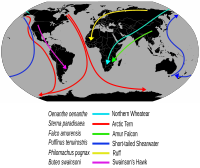
Photo from wikipedia
Applications of remote sensing data to monitor bird migration usher a new understanding of magnitude and extent of movements across entire flyways. Millions of birds move through the western USA,… Click to show full abstract
Applications of remote sensing data to monitor bird migration usher a new understanding of magnitude and extent of movements across entire flyways. Millions of birds move through the western USA, yet this region is understudied as a migratory corridor. Characterizing movements in the Pacific Flyway offers a unique opportunity to study complementary patterns to those recently highlighted in the Atlantic and Central Flyways. We use weather surveillance radar data from spring and autumn (1995–2018) to examine migrants' behaviours in relation to winds in the Pacific Flyway. Overall, spring migrants tended to drift on winds, but less so at northern latitudes and farther inland from the Pacific coastline. Relationships between winds and autumn flight behaviours were less striking, with no latitudinal or coastal dependencies. Differences in the preferred direction of movement (PDM) and wind direction predicted drift patterns during spring and autumn, with increased drift when wind direction and PDM differences were high. We also observed greater total flight activity through the Pacific Flyway during the spring when compared with the autumn. Such complex relationships among birds’ flight strategies, winds and seasonality highlight the variation within a migration system. Characterizations at these scales complement our understanding of strategies to clarify aerial animal movements.
Journal Title: Biology Letters
Year Published: 2019
Link to full text (if available)
Share on Social Media: Sign Up to like & get
recommendations!